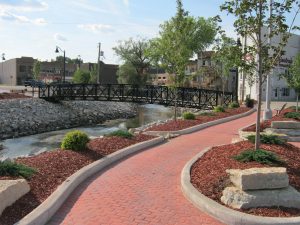When it comes to disaster preparedness, an ounce of prevention is worth a pound of cure.
However, there are other detailed and deliberate steps communities must take before, during and after a disaster event to ensure funding program compliance and the award of essential funding dollars. We’re talking about the three ‘R’s of hazard mitigation and emergency funding success: Resiliency, Readiness and Recovery.
Resiliency
Fortifying municipal infrastructure is key to community resiliency, yet these investments often come with a large price tag. Fortunately, the federal government has a couple of mitigation programs in place to assist. The goal of this funding is to reduce or eliminate losses and to break the cycle of disaster-incurred damages.
BRIC Funding
The former FEMA Pre-Disaster Mitigation Grant Program (PDM) has been replaced by a program called BRIC: Building Resilient Infrastructure and Communities (BRIC). The program remains fundamentally the same and support states, local communities, tribes and territories in efforts to protect life and property from future disaster damage.
BRIC shifts the federal focus away from reactive disaster spending and toward proactive, research-supported investments in community resilience. It encourages capability- and capacity-building, community innovation, partnerships, shared funding mechanisms, and large-scale risk reduction and disaster mitigation projects. BRIC awards infrastructure investments and the build-out of “community lifelines”— things that enable the operation of vital business, critical functions of government and bolster the health and safety of people and the economy.
Some uses of BRIC funding include the fortification or construction of buildings and municipal infrastructure, tornado shelters, flood levees, aquifers, stormwater systems, utility grids, seismic and wind retrofits or evacuation structures. The funding can also be used for the acquisition and demolition of damaged homes and businesses or the study, modeling, mapping or planning efforts pertaining to stormwater, floodplain, or emergency management systems and procedures.
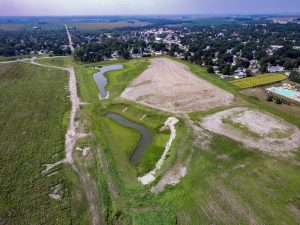
Award-winning stormwater detention basins protect Sumner, Iowa, from 100-year flooding events.
When pursuing BRIC funding, communities will apply as a sub-applicant of the state. Typically, the first step is to contact the applicant’s state Emergency Management/Homeland Security agency, which will then review the project, assess eligibility, and advise about next steps. Although the next BRIC grant program application deadline isn’t until January 2024, most states request that applications be completed a few months prior so they can be adequately reviewed before final submission. Communities with projects in mind for BRIC funding should consult with their applicant agency immediately to confirm sub-application deadlines, as they vary by state.
EJG2G Funding
The former Environmental Justice Cooperative Agreement Program has been replaced with the Environmental Justice Government-to-Government program (EJG2G), which was created by the Inflation Reduction Act and is funded at $20M for local governments and $20M for tribes. Grants of up to $1M at 100% federal funding will be awarded in 2023. Applications must be in partnership with a community-based organization. If awarded, the recipient has 3 years to complete the project with a start date of October 1, 2023. Example projects include planning in support of climate resiliency and adaptation, community revitalization addressing pollution and greenspace, addressing nonpoint sources of waterborne pollutants in underserved communities, addressing barriers to equitable transportation and mobility, disaster preparedness plans, disaster resiliency plans, emergency preparedness plans, land acquisition needed eligible projects, and others.
Applications are open now and due April 14, 2023. Note: the performance period cannot be extended beyond 3 years.
PROTECT Funding
The Promoting Resilient Operations for Transformative, Efficient, and Cost-Saving Transportation (PROTECT) competitive grant program for local governments was authorized by the Bipartisan Infrastructure Law and is funded with $1.4B over 4 years. Local governments in coastal states (including the Great Lakes) are eligible.
The program has both planning and resilience improvement (construction) grants. Planning grant funding may be used for pre-design, design, transportation disruption simulation, vulnerability assessments, capacity building, and evacuation planning and preparation. Resilience improvement grants may be used for construction projects that improve resiliency by reducing vulnerability of the transportation network to weather events, flooding, wildfire, or other natural disasters. Eligible projects include rehabilitation/reconstruction, etc. of a transportation facility, incorporating natural infrastructure, mitigation measures to prevent flooding of transportation systems, relocating roadways out of the floodplain, stabilizing slopes, installing riprap, increasing the size or number of drainage structures, adding scour protection at bridges, vegetation management in rights of way, and others.
Because PROTECT funding is not yet open, application details are not yet known. The Notice of Funding Opportunity (NOFO) is expected to be released in the spring of 2023.
Healthy Streets Program Funding
The Healthy Streets program was created by the Bipartisan Infrastructure Law but is not yet funded. Future appropriations bills may include funding for this program for low-income communities (at least 30% of the population lives below the poverty line). Eligible activities include assessments of urban heat islands, tree canopy assessments, equity assessments including mapping of flood-prone locations, deploying porous pavement to mitigate flooding and stormwater runoff, and others.
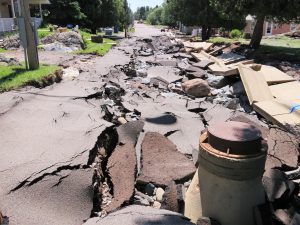
Readiness
Communities of all sizes, in all locations, should have emergency plans, practices and procedures as part of their playbooks. It begins with inventory and documentation of community assets, infrastructure, maintenance and investments. And it involves creating safeguards and redundancies to protect that data from any pending natural or man-made disaster.
Planning Ahead
Before disaster strikes, a community should do all it can to minimize the impacts of a hazardous event and be prepared to respond when an emergency does occur.
FEMA encourages all communities to prepare a Hazard Mitigation Plan. These plans include extensive public and stakeholder involvement; information on all natural and likely man-made hazards that could impact a community; a risk assessment for each potential hazard; inventory of critical assets and infrastructure; and a list of strategies to mitigate hazard impacts. A community must have a FEMA-approved Hazard Mitigation Plan in place to be eligible for the BRIC program. Funding is available through FEMA to develop Hazard Mitigation Plans which are usually completed as a multi-jurisdictional effort between a county, or multiple counties, and the municipalities within.
In addition to a Hazard Mitigation Plan, it is important to create a Disaster Emergency Response Plan that clearly details and defines the roles and responsibilities of all parties involved in preparation and response efforts. Coordination and communication between emergency services, local authorities, state and federal agencies is critical to the successful implementation of an emergency plan. The plan should include an assessment of disaster-prone areas and infrastructure, estimated frequency of occurrence (both historical and predicted/probable), location of emergency resources such as equipment, names and contact information of local, regional and state disaster response personnel, traffic and evacuation routes/corridors/detours and reliable community warning mechanisms.
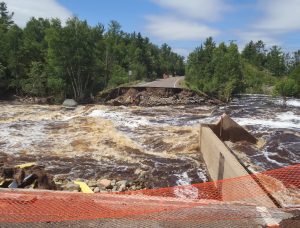
Inventory + GIS-based Asset Management
Being organized and prepared is one of the very best safeguards against natural disasters. It can also help secure communities critical funding dollars with much less hassle. First things first, take inventory. GPS-locate and take photos or video of all critical community assets, utilities and infrastructure. If disaster strikes, FEMA will want to know precise locations of these assets and the exact extent of damage incurred. Take detailed ‘before’ photos in hopes of never needing to take ‘after’ ones.
GIS can be instrumental and incredibly time saving when it comes to this inventory phase. GIS allows municipalities to streamline data collection, tracking and management of things like water, sewer and stormwater systems, pavement and road conditions. It can also be used for the inventory of public waterways and creeks or as a means to map urban forests and the GPS-specific location of tree species, health, and maintenance. This can be instrumental in assessing tree damage after a storm or validating preexisting versus storm-related conditions and the valuation of replacement. All of this is developed on a cloud-based asset management system, readily accessible to anyone in any location.
Record-keeping
All record-keeping, critical community files, and maintenance logs should also be secured and duplicated or migrated to online, cloud-based platforms if possible. Make copies of any essential paper data and think of how to make these documents the most resilient. Where should they be stored for safety in case of a storm? Will they incur water damage or destruction? Consider making multiple copies, transferring them to digital files, storing in a secure waterproof, fireproof vault such as within a bank, or use a third-party service for cloud storage. Redundancy and resiliency are key.
Operational Sustainability of Small Public Water Systems Funding
The Operational Sustainability of Small Public Water Systems grant program was created by the Bipartisan Infrastructure Law but is not yet funded. Future appropriations bills may include funding for this program for small community water systems (serve fewer than 10k). Eligible activities include development of a detailed drinking water asset inventory (water sources, wells, storage valves, treatment systems, distribution lines, hydrants, pumps, controls, and other essential infrastructure), development of infrastructure asset maps, leak detection technology, metering technology, and training in asset management. While the grant will only fund water-related projects, it could be a great way for communities to get started with GIS-based asset management.
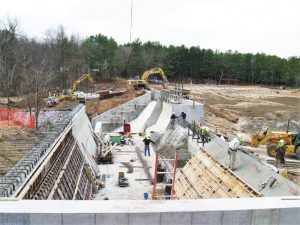
Construction of a new dam in Lake Delton, Wisconsin, after a devastating flood event in 2008.
Recovery
In the face of a potential disaster, it can be daunting to know what to do first. Thankfully, there are programs in place to help recoup disaster losses, fortify critical infrastructure, and fund emergency fixes as well as permanent solutions — all while keeping the safety and security of your citizens top of mind.
Hazard Mitigation Grant Program Funding
The Hazard Mitigation Grant Program (HMGP) is a funding mechanism that may be utilized only after a presidentially declared disaster. These grants aim to reduce disaster losses and to help citizens and communities recover from an emergency. They are awarded to eligible states, tribes and territories who may, in turn, provide sub-grants to local governments. While homeowners and businesses cannot directly apply for HMGP grants themselves, a local government may apply for funding on their behalf.
HMGP funds may be used to fund a variety of projects, including the retrofit of existing buildings to make them less susceptible to damage, purchasing hazard-prone property to remove residents or businesses from harm’s way, utility or infrastructure retrofits, drainage improvements, slope stabilization projects, aquifer storage, floodplain or stream restoration, flood diversion, green infrastructure, or the development and adoption of hazard mitigation plans, which are a requirement in order to receive funding.
Typically, HMGP applications are due to FEMA within 12 months of the date of the presidential major disaster declaration, but communities are best off contacting their state offices for application deadlines, as they can vary.
FEMA Public Assistance Program Funding
Similar to the Hazard Mitigation Grant Program discussed above, the FEMA Public Assistance Program begins with a presidential declaration and is tied to the official designation of such. These funds provide supplemental grant assistance to state, tribal, territorial and local governments — as well as eligible private non-profits — to respond to and recover from major emergencies or natural disasters. Once a disaster has been declared, many different layers of government and community organizations must be prepared to work together to meet program requirements and deadlines in a quick and efficient manner.
In this program, eligible projects funded must be categorized as either Emergency or Permanent. Emergency work is defined as either critical debris removal or emergency protective measures. Permanent work may include road and bridge reconstruction, water control facilities, public buildings and content, public utilities, and park, recreational or other vital public facilities. Emergency projects are required to be complete within six months; permanent work projects must be complete within 18 months. Both categories must prove to be essential as a result of the declared incident and must be located within the designated disaster area. Funding is directly tied to the eligible work and must be thoroughly “documented, authorized, necessary and reasonable,” with potential costs covering labor, equipment, materials, contract work and administration.
FEMA Public Assistance grants tend to evolve through a set of lifecycle phases: pre-award (application and award package development); award (approval and funding allocation); post-award (fund maintenance, monitoring and reporting), closeout (FEMA evaluation, financial/appeal reconciliation, final reporting, appeal/debt actions); and post-closeout (as necessary, FEMA debt collections, audits or adjustments). It is imperative for communities seeking public assistance dollars to be meticulous in their maintenance and recording logs in order to gain reimbursement for damages.
Recipe for Success
While no plan is entirely infallible and no funding guaranteed, communities that follow the ‘triple R’ recipe are better positioned to identify infrastructure deficiencies and opportunities for improvement — then pursue funding sources that will benefit them most. And do so in a proactive manner, which is truly the lynchpin of success in today’s competitive funding environment.
Need some assistance? We’re here to help. Learn more about MSA’s Funding services, request a consultation or meet the experts who can help you succeed.
